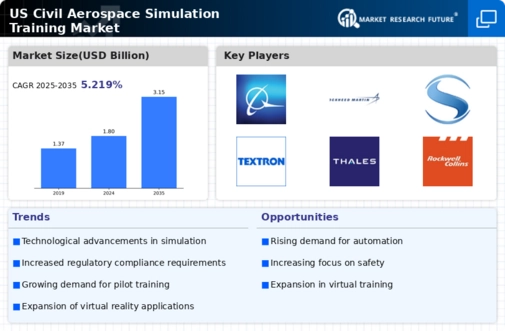Growing Demand for Pilot Training
The civil aerospace-simulation-training market is experiencing a notable increase in demand for pilot training programs. This surge is primarily driven by the rising number of commercial flights and the need for qualified pilots. According to the Federal Aviation Administration (FAA), the U.S. is projected to require approximately 18,000 new pilots by 2038. This demand necessitates advanced training solutions, which simulation technologies can effectively provide. The ability to replicate real-world flying conditions in a controlled environment enhances pilot preparedness and safety. Consequently, training organizations are investing in sophisticated simulation systems to meet this growing need, thereby propelling the civil aerospace-simulation-training market forward.
Expansion of Aviation Sector in the U.S.
The expansion of the aviation sector in the U.S. is a significant driver of the civil aerospace-simulation-training market. With the increasing number of airlines and the expansion of existing ones, there is a heightened need for trained personnel. The Bureau of Transportation Statistics indicates a steady growth in passenger air travel, which necessitates a corresponding increase in pilot and crew training. This growth creates opportunities for simulation training providers to offer tailored solutions that meet the evolving needs of the aviation industry. As the sector continues to expand, the demand for effective training solutions is expected to rise, further propelling the civil aerospace-simulation-training market.
Regulatory Compliance and Safety Standards
Regulatory compliance plays a crucial role in shaping the civil aerospace-simulation-training market. The FAA and other regulatory bodies impose stringent safety standards that training programs must adhere to. These regulations often require the use of advanced simulation technologies to ensure that pilots and crew are adequately prepared for real-world scenarios. As safety remains a top priority in aviation, training organizations are increasingly adopting simulation-based training to meet these regulatory requirements. This trend not only enhances the quality of training but also fosters confidence among stakeholders, thereby driving growth in the civil aerospace-simulation-training market.
Technological Advancements in Simulation Tools
Technological advancements are significantly influencing the civil aerospace-simulation-training market. Innovations such as virtual reality (VR), augmented reality (AR), and artificial intelligence (AI) are transforming traditional training methodologies. These technologies provide immersive training experiences that enhance learning outcomes and retention rates. For instance, the integration of AI in simulation tools allows for personalized training experiences, adapting to the individual needs of trainees. As these technologies continue to evolve, they are likely to attract more investment and interest from training organizations, further stimulating growth in the civil aerospace-simulation-training market.
Increased Focus on Cost-Effective Training Solutions
The civil aerospace-simulation-training market is witnessing a shift towards cost-effective training solutions. As airlines and training organizations seek to optimize their budgets, simulation training offers a viable alternative to traditional flight training. Simulators reduce operational costs associated with fuel, maintenance, and aircraft wear and tear. Moreover, they allow for more flexible training schedules, minimizing downtime for aircraft. This focus on cost efficiency is prompting organizations to invest in simulation technologies, which are perceived as a long-term solution to training challenges. Consequently, this trend is likely to bolster the civil aerospace-simulation-training market.




















Leave a Comment